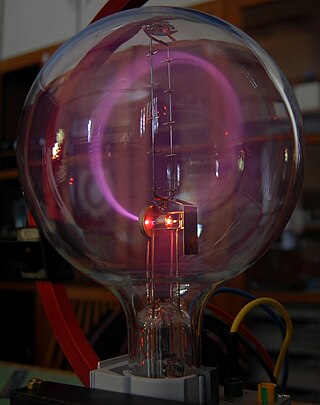
Cathode rays or electron beams (e-beam) are streams of electrons observed in discharge tubes. If an evacuated glass tube is equipped with two electrodes and a voltage is applied, glass behind the positive electrode is observed to glow, due to electrons emitted from the cathode. They were first observed in 1859 by German physicist Julius Plücker and Johann Wilhelm Hittorf, and were named in 1876 by Eugen Goldstein Kathodenstrahlen, or cathode rays. In 1897, British physicist J. J. Thomson showed that cathode rays were composed of a previously unknown negatively charged particle, which was later named the electron. Cathode-ray tubes (CRTs) use a focused beam of electrons deflected by electric or magnetic fields to render an image on a screen.

X-rays (X-radiation) are a form of high-energy electromagnetic radiation. In many languages, it is referred to as Röntgen radiation, after the German scientist Wilhelm Conrad Röntgen, who discovered it in 1895 and named it X-radiation to signify an unknown type of radiation.
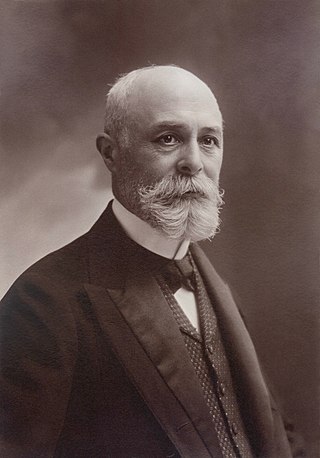
Antoine Henri Becquerel was a French engineer, physicist, Nobel laureate, and the first person to discover radioactivity. For work in this field he, along with Marie Skłodowska-Curie and Pierre Curie, received the 1903 Nobel Prize in Physics. The SI unit for radioactivity, the becquerel (Bq), is named after him.

Radiography is an imaging technique using X-rays, gamma rays, or similar ionizing radiation and non-ionizing radiation to view the internal form of an object. Applications of radiography include medical and industrial radiography. Similar techniques are used in airport security,. To create an image in conventional radiography, a beam of X-rays is produced by an X-ray generator and it is projected towards the object. A certain amount of the X-rays or other radiation are absorbed by the object, dependent on the object's density and structural composition. The X-rays that pass through the object are captured behind the object by a detector. The generation of flat two-dimensional images by this technique is called projectional radiography. In computed tomography, an X-ray source and its associated detectors rotate around the subject, which itself moves through the conical X-ray beam produced. Any given point within the subject is crossed from many directions by many different beams at different times. Information regarding the attenuation of these beams is collated and subjected to computation to generate two-dimensional images on three planes which can be further processed to produce a three-dimensional image.

An X-ray machine is a device that uses X-rays for a variety of applications including medicine, X-ray fluorescence, electronic assembly inspection, and measurement of material thickness in manufacturing operations. In medical applications, X-ray machines are used by radiographers to acquire x-ray images of the internal structures of living organisms, and also in sterilization.

Walther Wilhelm Georg Bothe was a German nuclear physicist known for the development of coincidence methods to study particle physics.

Philipp Eduard Anton von Lenard was a Hungarian-German physicist and the winner of the Nobel Prize in Physics in 1905 for his work on cathode rays and the discovery of many of their properties. One of his most important contributions was the experimental realization of the photoelectric effect. He discovered that the energy (speed) of the electrons ejected from a cathode depends only on the frequency, and not the intensity, of the incident light.

A Crookes tube is an early experimental electrical discharge tube, with partial vacuum, invented by English physicist William Crookes and others around 1869–1875, in which cathode rays, streams of electrons, were discovered.

Johann Wilhelm Hittorf was a German physicist who was born in Bonn and died in Münster, Germany.
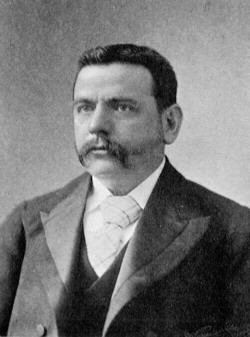
John Macintyre or Mcintyre FRSE was a Scottish medical doctor who set up the world's first radiology department at the Glasgow Royal Infirmary, in Glasgow.

Radiographers, also known as radiologic technologists, diagnostic radiographers and medical radiation technologists are healthcare professionals who specialise in the imaging of human anatomy for the diagnosis and treatment of pathology. Radiographers are infrequently, and almost always erroneously, known as x-ray technicians. In countries that use the title radiologic technologist they are often informally referred to as techs in the clinical environment; this phrase has emerged in popular culture such as television programmes. The term radiographer can also refer to a therapeutic radiographer, also known as a radiation therapist.
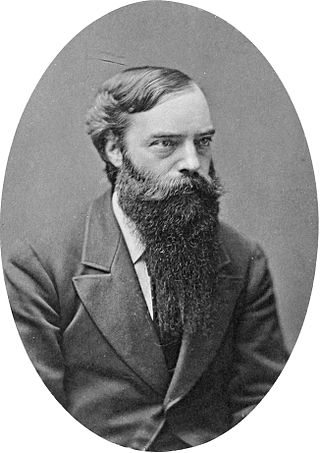
Arthur Williams Wright was an American physicist. Wright spent most of his scientific career at Yale University, where he received the first science Ph.D. awarded outside of Europe. His research, which ranged from electricity to astronomy, produced the first X-ray image and experimented with Röntgen rays. He also proved instrumental in securing funding for the first dedicated physics laboratory building in the United States, the Sloane Physical Laboratory.

Franz Serafin Exner was an Austrian physicist and professor at the University of Vienna. He is known for pioneering physical chemistry education in Austria. The early introduction to university curricula of subjects such as radioactivity, spectroscopy, electrochemistry electricity in the atmosphere, and color theory in Austria are often credited to him.
Clarence Madison Dally was an American glassblower, noted as an assistant to Thomas Edison in his work on X-rays and as an early victim of radiation dermatitis and its complications. He is thought to be the first human death resulting from X-ray exposure.

The Röntgen Memorial Site in Würzburg, Germany, is dedicated to the work of the German physicist Wilhelm Conrad Röntgen (1845–1923) and his discovery of X-rays, for which he was granted the Nobel Prize in physics. It contains an exhibition of historical instruments, machines and documents.

Charles Thurstan Holland was an English general practitioner in Liverpool who was best known by his pioneering research in the field of radiology. The Thurstan Holland sign is named after him.
Joseph Patrick Slattery, CM was an Irish-born physicist, radiologist, Catholic priest, pioneer in the field of radiography in Australia and credited with the first use of fluoroscopy in Australia.
Karl Friedrich Schall was a German precision engineer and co-founder of the company Reiniger, Gebbert & Schall (RGS) in Erlangen. RGS was a manufacturer and supplier of durable medical equipment and a pioneer in the supply of x-ray equipment worldwide with offices in Berlin, Wien, London, Paris, Rome, Chicago and Sydney.

Dawson Fyers Duckworth Turner, FRSE, FRCPE (1857–1928) was a British pioneer of radiology and patron of the arts, who died of radiation related cancer.
Wolfram Conrad Fuchs (1865–1908) was a German-born electrical engineer who became a pioneer in radiography. He opened the first x-ray laboratory in the United States in Chicago, and had completed over 1400 x-ray examinations by 1896. His work was critical to the history of radiation protection. He was the father of Arthur Wolfram Fuchs, the inventor of the fixed kilovoltage technique of radiography.
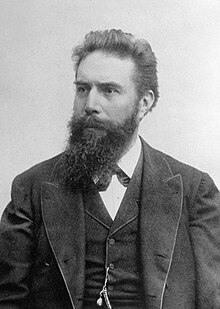
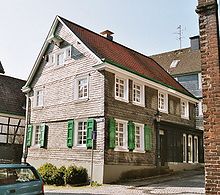

![Rontgen]'s marble bust at the Deutsches Museum in Munich Munchen-2026-Deutsches Museum-Rontgen.jpg](http://upload.wikimedia.org/wikipedia/commons/thumb/2/27/M%C3%BCnchen-2026-Deutsches_Museum-R%C3%B6ntgen.jpg/170px-M%C3%BCnchen-2026-Deutsches_Museum-R%C3%B6ntgen.jpg)


















